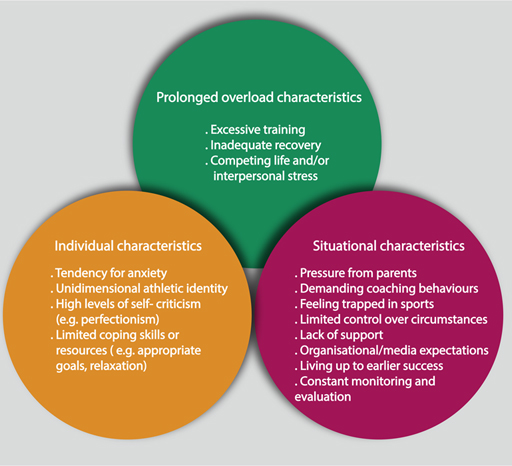4 Fifteen factors influencing burnout
So far you have looked at what burnout is, why it occurs and how it might be measured.
You will now review a list of fifteen factors influencing burnout which have been compiled from recent research reviews in this area (Gustafsson et al. (2017); Eklund and Defreese (2017)) by the authors of this course. These fifteen factors cover all the key theoretical ideas you need to be aware of – the list is a teaching tool to help your understanding, not a comprehensive evaluation.
The fifteen factors have been divided into three categories to help make sense of this complex phenomenon:
- individual characteristics (i.e. a person’s attributes and personal resources)
- prolonged overload (i.e. the stress stimulus and response to it), and
- situational characteristics (i.e. the environmental and social influences).
To help you gain a deeper understanding of the burnout factors, the following activity now challenges you to categorise the fifteen burnout factors under these three headings.
Activity 4 Categorising the fifteen burnout factors
Read the list of fifteen factors (1–15) below and identify which of the three categories (individual characteristics; prolonged overload; situational characteristics) each factor falls under. Use the highlight tool and select the relevant words once to colour code the list into three colours.
- Identify factors falling under the individual characteristics category in yellow.
- Identify factors falling under the prolonged overload characteristics category in green.
- Identify factors falling under the situational characteristics category in red.
The fifteen burnout factors are:
Discussion
A colour coded summary of the categorised factors is available in Figure 4.

When categorising factors you often find that there are relatively straightforward items that easily fit into a category and then those that are less clear cut. For example, you may have found those factors connected to the individual (yellow factors) easier to place, such as: tendency for anxiety, unidimensional athletic identity, high levels of self-criticism (e.g. perfectionism) and limited coping skills.
Deciding what are prolonged overload items (green factors) may be more a matter of judgement, but factors that address long-standing features of sport such as excessive training, inadequate recovery along with competing life and/or interpersonal stress perhaps fit best here.
All the other factors (situational characteristics, red factors) are to some extent dependent on the context and environment in which a person trains. These include: feeling trapped in sport, limited control over circumstances, lack of support, and pressures/expectations (five sources of pressure fit under this label: parents, coaches, organisations/media, earlier success and constant monitoring).
You have covered a lot of new material and ideas about burnout in this session. To help pull these ideas together in the next section you will hear from three academics talking about the varied influences and perspective on burnout covered.
